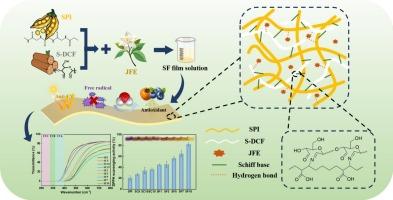希夫碱交联大豆蛋白/双醛纤维素/茉莉渣提取物薄膜:抗氧化、防紫外线水果保鲜
IF 5.1
3区 工程技术
Q1 CHEMISTRY, APPLIED
引用次数: 0
摘要
为解决石油基塑料薄膜的局限性,满足日益增长的可持续食品包装需求,以大豆分离蛋白(SPI)为基质,开发了一种新型可生物降解复合薄膜。利用从桑树枝中提取和修饰的水溶性双醛纤维素(S-DCF)中SPI中的氨基和活性醛基团,通过动态希夫碱反应(- ch =N-)构建了三维网络结构。这种交联效应减少了蛋白质分子链的滑移,改善了链段的有序性,使膜的抗拉强度提高了154%。同时,醛氧化引入的极性基团通过氢键增强了界面相容性,协同优化了水蒸气阻隔性能,形成了“化学交联-物理纠缠”的双重增强机制。此外,从茉莉花残基中提取的黄酮类化合物(JFE)通过酚羟基给氢共轭芳香环结构协同实现了清除自由基(清除率82%)和屏蔽紫外线(200-400 nm波段透射率1%)的双重功能。此外,复合膜在土壤中表现出良好的生物降解性,有效延缓了柿子和蓝莓等水果的水分流失和腐烂,实现了积极的“包装-环境”循环,证实了其作为一种活性和可持续包装材料的潜力。本文章由计算机程序翻译,如有差异,请以英文原文为准。

Schiff base crosslinked soy protein/dialdehyde cellulose/jasmine residue extract films: Antioxidant, UV-shielding for fruit preservation
To address the limitations of petroleum-based plastic films and meet the growing demand for sustainable food packaging, a new biodegradable composite film was developed using soy protein isolate (SPI) as the matrix. The amino groups in SPI and the active aldehyde groups in water-soluble dialdehyde cellulose (S-DCF), extracted and modified from mulberry branches, were utilized to construct a three-dimensional network structure through a dynamic Schiff base reaction (-CH=N-). This cross-linking effect reduced the slippage of the protein molecular chain and improved the orderliness of the chain segments, increasing the tensile strength of the film by 154 %. Meanwhile, the polar groups introduced by aldehyde oxidation enhanced interfacial compatibility through hydrogen bonds, synergistically optimizing the water vapor barrier properties and forming a dual enhancement mechanism of “chemical cross-linking-physical entanglement.” Additionally, the flavonoids (JFE) extracted from jasmine residues synergistically achieved the dual functions of free radical scavenging (scavenging rate of 82 %) and UV shielding (transmittance in the 200–400 nm band <1 %) through the phenolic hydroxyl hydrogen donation-conjugated aromatic ring structure. Furthermore, the composite film demonstrated excellent biodegradability in soil and effectively delayed the water loss and decay of fruits such as persimmons and blueberries, realizing a positive “packaging-environment” cycle and confirming its potential as an active and sustainable packaging material.
求助全文
通过发布文献求助,成功后即可免费获取论文全文。
去求助
来源期刊

Reactive & Functional Polymers
工程技术-高分子科学
CiteScore
8.90
自引率
5.90%
发文量
259
审稿时长
27 days
期刊介绍:
Reactive & Functional Polymers provides a forum to disseminate original ideas, concepts and developments in the science and technology of polymers with functional groups, which impart specific chemical reactivity or physical, chemical, structural, biological, and pharmacological functionality. The scope covers organic polymers, acting for instance as reagents, catalysts, templates, ion-exchangers, selective sorbents, chelating or antimicrobial agents, drug carriers, sensors, membranes, and hydrogels. This also includes reactive cross-linkable prepolymers and high-performance thermosetting polymers, natural or degradable polymers, conducting polymers, and porous polymers.
Original research articles must contain thorough molecular and material characterization data on synthesis of the above polymers in combination with their applications. Applications include but are not limited to catalysis, water or effluent treatment, separations and recovery, electronics and information storage, energy conversion, encapsulation, or adhesion.
 求助内容:
求助内容: 应助结果提醒方式:
应助结果提醒方式:


